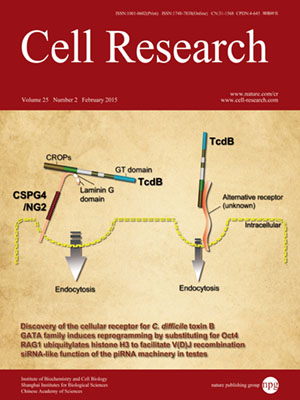Volume 25 Issue 2, February 2015: 208-224
ORIGINAL ARTICLES
Anticancer immunotherapy by CTLA-4 blockade: obligatory contribution of IL-2 receptors and negative prognostic impact of soluble CD25
Dalil Hannani1,2,3,*, Marie Vétizou1,2,3,*, David Enot1,4,5, Sylvie Rusakiewicz1,2,6, Nathalie Chaput1,2,6, David Klatzmann7,8, Nicolas Jacquelot1,2,3, Nadège Vimond1,2,6, Salem Chouaib9, Christine Mateus1,10, James P Allison11, Antoni Ribas12, Jedd D Wolchok13, Jianda Yuan13, Philip Wong13, Michael Postow13, Andrzej Mackiewicz14,15, Jacek Mackiewicz14,15, Dirk Schadendorff16, Dirk Jaeger17, Alan J Korman18, Keith Bahjat19, Michele Maio20, Luana Calabro20, Michele WL Teng21,22, Mark J Smyth21,22, Alexander Eggermont1,2,23, Caroline Robert1,2,10,23, Guido Kroemer1,4,5,24,25,26 and Laurence Zitvogel1,2,3,10
1Gustave Roussy Cancer Campus, Villejuif, France
2INSERM U1015, Villejuif, France
3Université Paris Sud-XI, Faculté de Médecine, Le Kremlin Bicêtre, France
4INSERM U848, Villejuif, France
5Metabolomics Platform, Institut Gustave Roussy, Villejuif, France
6Center of Clinical Investigations in Biotherapies of Cancer (CICBT) 507, Villejuif, France
7INSERM, Unité Mixte de Recherche_S959, I3, Paris, France
8Assistance-Publique Hopitaux de Paris, Hôpital Pitié-Salpêtrière, Biotherapy, Paris, France
9INSERM U753, Villejuif, France
10Department of Medical Oncology, IGR, Villejuif, France
11Department of Immunology, MD Anderson Cancer Center, Houston, TX, USA
12University of California Los Angeles, Los Angeles, CA, USA
13Ludwig Center for Cancer Immunotherapy, Department of Immunology, and Department of Medicine, Memorial Sloan-Kettering Cancer Center, New York, NY, USA
14Department of Diagnostics and Cancer Immunology, Greater Poland Cancer Centre, Poznan, Poland
15Chair of Medical Biotechnology, Poznan University of Medical Sciences, Poznan, Poland
16Department of Dermatology, University Hospital Essen, Germany
17National Center for Tumor Diseases, University Hospital, Heidelberg, Germany
18Bristol-Myers Squibb, Redwood City, CA, USA
19Earle A Chiles Research Institute, Robert W. Franz Cancer Center, Providence Portland Medical Center, Portland, OR, USA
20Medical Oncology and Immunotherapy, Department of Oncology, University Hospital of Siena, Istituto Toscano Tumori, Siena, Italy
21QIMR Berghofer Medical Research Institute, Herston, 4006, Queensland, Australia
22School of Medicine, The University of Queensland, Herston, QLD 4006, Queensland, Australia
23INSERM U981, Villejuif, France
24Equipe 11 labellisée Ligue contre le Cancer, Centre de Recherche des Cordeliers, INSERM U 1138, Paris, France
25Pôle de Biologie, Hôpital Européen Georges Pompidou, AP-HP, Paris, France
26Université Paris Descartes, Sorbonne Paris Cité, Paris, France
Correspondence: Laurence Zitvogel, E-mail: laurence.zitvogel@gustaveroussy.fr; Guido Kroemer,(kroemer@orange.fr)
The cytotoxic T lymphocyte antigen-4 (CTLA-4)-blocking antibody ipilimumab induces immune-mediated long-term control of metastatic melanoma in a fraction of patients. Although ipilimumab undoubtedly exerts its therapeutic effects via immunostimulation, thus far clinically useful, immunologically relevant biomarkers that predict treatment efficiency have been elusive. Here, we show that neutralization of IL-2 or blocking the α and β subunits of the IL-2 receptor (CD25 and CD122, respectively) abolished the antitumor effects and the accompanying improvement of the ratio of intratumoral T effector versus regulatory cells (Tregs), which were otherwise induced by CTLA-4 blockade in preclinical mouse models. CTLA-4 blockade led to the reduction of a suppressive CD4+ T cell subset expressing Lag3, ICOS, IL-10 and Egr2 with a concomitant rise in IL-2-producing effector cells that lost FoxP3 expression and accumulated in regressing tumors. While recombinant IL-2 improved the therapeutic efficacy of CTLA-4 blockade, the decoy IL-2 receptor α (IL-2Rα, sCD25) inhibited the anticancer effects of CTLA-4 blockade. In 262 metastatic melanoma patients receiving ipilimumab, baseline serum concentrations of sCD25 represented an independent indicator of overall survival, with high levels predicting resistance to therapy. Altogether, these results unravel a role for IL-2 and IL-2 receptors in the anticancer activity of CTLA-4 blockade. Importantly, our study provides the first immunologically relevant biomarker, namely elevated serum sCD25, that predicts resistance to CTLA-4 blockade in patients with melanoma.
10.1038/cr.2015.3
FULL TEXT | PDF
Browse 2075


